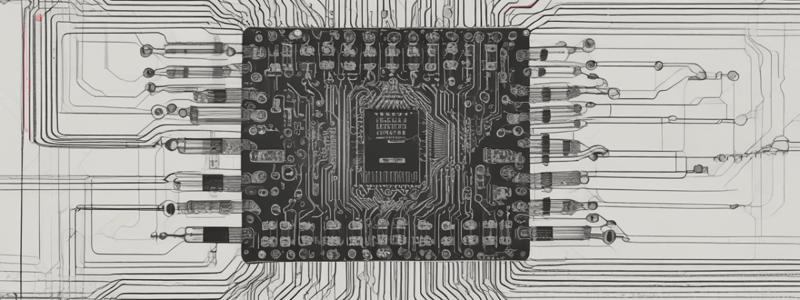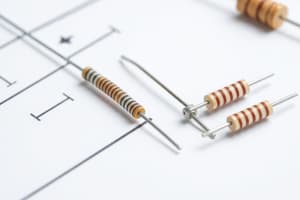Podcast
Questions and Answers
What is a key characteristic of parallel circuits?
What is a key characteristic of parallel circuits?
- Total current is zero
- Multiple paths for current (correct)
- Different voltage across each resistor
- Increased total resistance
What is the voltage across each resistor in a parallel circuit?
What is the voltage across each resistor in a parallel circuit?
- Zero voltage
- The same as the voltage across the battery (correct)
- Dependent on the resistance of each resistor
- Half of the total voltage
What happens to the total resistance in a parallel circuit?
What happens to the total resistance in a parallel circuit?
- It increases with the addition of more resistors
- It decreases with the addition of more resistors (correct)
- It becomes infinite
- It remains the same
How does the current behave in a parallel circuit?
How does the current behave in a parallel circuit?
What is the formula for calculating the total resistance in a parallel circuit?
What is the formula for calculating the total resistance in a parallel circuit?
What is the total current in a parallel circuit?
What is the total current in a parallel circuit?
Why do parallel circuits have multiple paths for current?
Why do parallel circuits have multiple paths for current?
What is the relationship between the voltage across each resistor and the voltage across the battery in a parallel circuit?
What is the relationship between the voltage across each resistor and the voltage across the battery in a parallel circuit?
What determines the portion of the total current that each path carries in a parallel circuit?
What determines the portion of the total current that each path carries in a parallel circuit?
In a parallel circuit, what is the relationship between the total current and the currents through each branch?
In a parallel circuit, what is the relationship between the total current and the currents through each branch?
What is the advantage of having multiple paths for current in a parallel circuit?
What is the advantage of having multiple paths for current in a parallel circuit?
What is the consequence of connecting resistors in parallel on the total resistance?
What is the consequence of connecting resistors in parallel on the total resistance?
What is the voltage across each resistor in a parallel circuit with three resistors connected to a battery with voltage V?
What is the voltage across each resistor in a parallel circuit with three resistors connected to a battery with voltage V?
What is the reason why the voltage across each resistor is the same in a parallel circuit?
What is the reason why the voltage across each resistor is the same in a parallel circuit?
What happens to the current through each resistor when more resistors are added in parallel?
What happens to the current through each resistor when more resistors are added in parallel?
Why is the total resistance in a parallel circuit less than the resistance of the smallest individual resistor?
Why is the total resistance in a parallel circuit less than the resistance of the smallest individual resistor?
What is the main reason why the total current in a parallel circuit splits across different paths?
What is the main reason why the total current in a parallel circuit splits across different paths?
What is the relationship between the total current and the currents through each branch in a parallel circuit?
What is the relationship between the total current and the currents through each branch in a parallel circuit?
What happens to the total resistance when more resistors are added in parallel?
What happens to the total resistance when more resistors are added in parallel?
What is the significance of the voltage being the same across each resistor in a parallel circuit?
What is the significance of the voltage being the same across each resistor in a parallel circuit?
What determines the portion of the total current that each path carries in a parallel circuit?
What determines the portion of the total current that each path carries in a parallel circuit?
What is the consequence of having multiple paths for current in a parallel circuit?
What is the consequence of having multiple paths for current in a parallel circuit?
Why is the total resistance in a parallel circuit less than the resistance of the smallest individual resistor?
Why is the total resistance in a parallel circuit less than the resistance of the smallest individual resistor?
What is the advantage of connecting resistors in parallel?
What is the advantage of connecting resistors in parallel?
What is the primary reason why the total current in a parallel circuit is divided among the different paths?
What is the primary reason why the total current in a parallel circuit is divided among the different paths?
What is the relationship between the total current and the currents through each branch in a parallel circuit when the resistors are identical?
What is the relationship between the total current and the currents through each branch in a parallel circuit when the resistors are identical?
What happens to the total resistance when the number of resistors in a parallel circuit is increased?
What happens to the total resistance when the number of resistors in a parallel circuit is increased?
What is the condition necessary for the voltage across each resistor to be the same in a parallel circuit?
What is the condition necessary for the voltage across each resistor to be the same in a parallel circuit?
What is the effect of increasing the voltage supplied by the battery on the total current in a parallel circuit?
What is the effect of increasing the voltage supplied by the battery on the total current in a parallel circuit?
What is the relationship between the resistance of each resistor and the total resistance in a parallel circuit?
What is the relationship between the resistance of each resistor and the total resistance in a parallel circuit?
What is the advantage of connecting resistors in parallel in terms of current?
What is the advantage of connecting resistors in parallel in terms of current?
What is the formula for calculating the total resistance in a parallel circuit?
What is the formula for calculating the total resistance in a parallel circuit?




